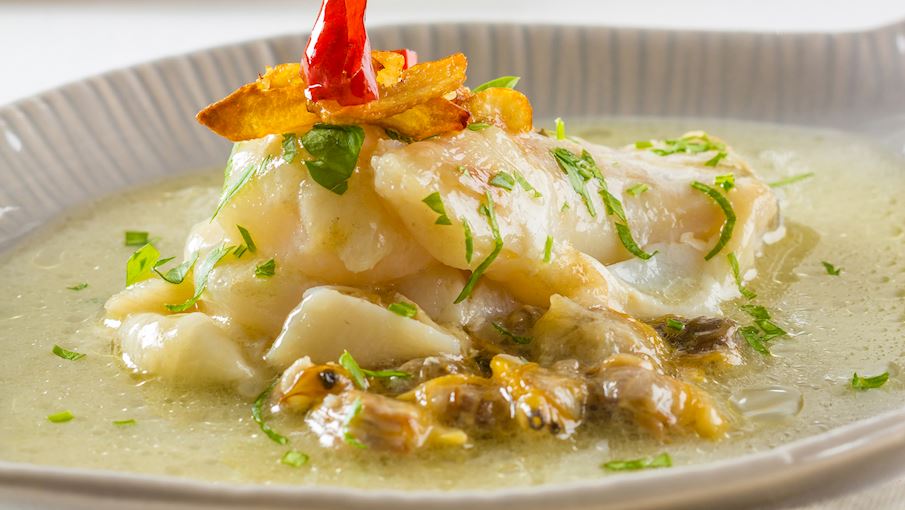Gelatinous fish heads known as kokotxas are a key ingredient for this classic Basque dish. Kokotxas usually come from the flashy cheeks (lower part of chin) of hake or cod. The dish is sometimes served in a sauce consisting of white wine, garlic, flour, and olive oil.
A more traditional way of serving kokotxas is in salsa verde sauce, consisting of olive oil, flour, fish stock, garlic, and finely chopped parsley. The kokotxas are lightly fried in a clay casserole pot, then combined with the sauce. It's recommended to serve the dish with crusty bread on the side for mopping up the sauce.
MAIN INGREDIENTS
Espetos is a Spanish tradition of grilling sardines, dating back to the late 19th century, when fishermen skewered and grilled surplus fish in small boats on the sand. The modern method usually involves placing 6 sardines on a skewer, seasoning them with sea salt, then grilling them over the open flames of an olive wood fire.
Once the sardines are fully cooked and become golden on the outside, they are drizzled with olive oil and lemon juice. It's said that the sardines are best from May to August, when they are a bit fattier, which increases their great flavor. In many beach bars of Malaga, espetos are paired with soft drinks, beer, sangria, or Tinto de verano red wine.
MOST ICONIC Espetos
View moreMAIN INGREDIENTS
Croquetas de bacalao are Spanish fritters made with cod. Although Spanish croquetas are mainly made with a béchamel base, this popular salt cod variety occasionally replaces béchamel with mashed potatoes. Both options are well-seasoned and mixed with cooked and flaked salt cod before the dough is shaped into desired forms.
Each piece is coated in breadcrumbs and finally fried until golden and crispy. The cod version is one of the most common types of croquetas found in Spain, and like other varieties, it is a staple tapas dish enjoyed throughout the country.
MOST ICONIC Croquetas de bacalao
View moreMAIN INGREDIENTS
Grilled sardines are a simple, traditional seafood dish especially common in coastal Mediterranean areas and during summer months, when fresh sardines are plentiful. The dish is straightforward and emphasizes the natural flavors of the sardines: they are typically marinated in a mixture of olive oil, lemon juice, black pepper, and salt (although a variety of spices and herbs can also be added, depending on the region) before being grilled over a charcoal fire.
The dish is usually served as an appetizer or a part of a meze, along with bread, boiled potatoes, sautéed vegetables, or salads, and is best paired with lighter, sweeter local white wines.
MAIN INGREDIENTS
Bacalao al pil-pil is a traditional dish originating from the Basque Country. It is prepared with only four ingredients: salt cod, olive oil, garlic, and chili peppers. The cod is cooked in olive oil (with garlic and chili peppers), releasing gelatin that is needed for the emulsification of the sauce later on.
Making pil-pil is a laborious process, taking anywhere from 15 to 30 minutes, and the final result is a creamy sauce that is spooned over the cod before serving. It is recommended to garnish the dish with leftovers garlic and chili peppers, then serve it hot or warm.
MAIN INGREDIENTS
Marmitako is an excellent representative of the Basque Country cuisine, a tuna stew made in a pot with various other ingredients such as potatoes, tomatoes, chili, and onions. The name of the dish is derived from the Basque word marmita, denoting a pot or a casserole.
When combined with the suffix –ko, it can be literally translated as from the pot. Originally, the stew was invented on fishing boats near the Spanish coast, and while tuna is the most authentic option, today there are numerous variations on the dish, depending on the type of fish used in the preparation of marmitako.
Bacalao a la Vizcaina or Basque-style cod is a traditional dish that's also popular in many Spanish-speaking countries. The dish is made with salt cod fillets in Vizcaina sauce. The sauce consists of red onions, garlic, and choricero pepper purée, although some people also like to add tomatoes to the mix.
The fish is cooked, and the sauce is poured over the fillets. The dish is traditionally served warm.
Rodaballo a la gallega is a traditional fish dish originating from Galicia. It's usually made with a combination of turbot, white wine, onions, carrots, leeks, potatoes, parsley, peppercorns, and salt. The fish and vegetables are boiled until tender, and the turbot is then cut lengthwise and arranged on a plate with the boiled vegetables.
Just before serving, the dish is covered with a sauce consisting of garlic, olive oil, onions, bay leaves, pimentón, lemon juice, and salt.
Known as ''the caviar of Northern Spain,'' angulas are baby eels, a Spanish seafood delicacy that's typically consumed with oil and garlic. They're also one of Spain's most expensive foods, reaching prices of up to 1,000 euros per kilo, which is pretty strange for some people who claim they don't taste of much at all.
However, others praise angulas for their delicate, meaty texture. When alive, the baby eels are slimy and transparent, and when cooked, they turn opaque-white. The most traditional recipe for the preparation of these eels comes from Bilbao (Angulas a la Bilbaína), and it calls for frying hot peppers and garlic in olive oil, then adding the baby eels to the mix.
Boquerones fritos is a traditional fish dish originating from Andalusia. The dish consists of deep-fried anchovies and it's usually made with a combination of fresh anchovies, olive oil, flour, and salt. The cleaned anchovies are sprinkled with salt, coated with flour, and then fried over medium-high heat in olive oil until golden and crisp.
Once all the anchovies have been fried, they are arranged on a platter and served while still hot. It's recommended to try this Andalusian specialty in one of its seaside bars.
TasteAtlas food rankings are based on the ratings of the TasteAtlas audience, with a series of mechanisms that recognize real users and that ignore bot, nationalist or local patriotic ratings, and give additional value to the ratings of users that the system recognizes as knowledgeable. TasteAtlas Rankings should not be seen as the final global conclusion about food. Their purpose is to promote excellent local foods, instill pride in traditional dishes, and arouse curiosity about dishes you haven’t tried.























